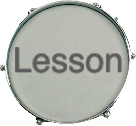How To Improve Drum Timing And Read Drum Rhythm
Drum timing is every drummers best friend, as I have said to many of my students you can be the best band in the world with the worst drummer and your band will suck! Vise-versa worst band with a great drummer and you’ve got the recipe for a rocking band and this all boils down to whether you have good drum timing. It’s not how fast you can play, how many fills you can throw in or even how many stick tricks you can do to impress the crowd if you can’t keep any of the previous in time you might as well give up now.
But before you go running out the door read on cos drum lessons beginners is going to show you just how easy it is to get perfect drum timing! If you can count to four you can play the drums, if you can’t well, ok I’ll let you go for the door now.
If you haven’t read the lesson on how to read drum sheet music I highly recommend you go read that first, if your cool reading drum music then read on.
Drum Timing and Rhythm Basics
Can you count to four?
Before you learn to develop your drum timing and learn how to read rhythms it is important to understand the fundamentals of rhythm.
All music has a PULSE and understanding the pulse is the essence to you developing good drum timing.
Here is an example that might help you understand the basics of pulse. Listen to a song you like and tap your foot to the music, keep it steady and keep the rhythm even. When you tap your foot or even nod (mosh) your head in time to the music you are feeling and responding to the pulse of the music.
The pulse or beat is counted in groups of numbers the most common being groups of 4 (see the example below
|1 2 3 4 | 1 2 3 4|
Crochets/Quarter Notes
Now as we now from how to read drum music notes aren’t written as numbers so the basic count or pulse must be represented with a symbol.
Check out the symbol below it is a dot with a stem and is called a CROCHET, for US readers it’s called a QUARTER NOTE.
Now we can replace our count of four into groups of crochets as shown below, you should practice and aim to keep the count as steady as possible, don’t slow down or speed up as you play.
 1..2..3..4.. is all you have to do, yes I know it seems and is stupidly easy but you would be amazed at how having a clear understanding of how to keep the pulse steady with crochets will dramatically improve your drum timing. Next time you listen to your favorite drummers listen out for how many times they go out of time. I’m willing to bet my beloved drum set that you won’t hear them going out of time because they have a clear understanding of the pulse.
1..2..3..4.. is all you have to do, yes I know it seems and is stupidly easy but you would be amazed at how having a clear understanding of how to keep the pulse steady with crochets will dramatically improve your drum timing. Next time you listen to your favorite drummers listen out for how many times they go out of time. I’m willing to bet my beloved drum set that you won’t hear them going out of time because they have a clear understanding of the pulse.
How do they get so fast? It’s 40% practice and 60% understanding the pulse and drum timing. No point in trying to play fast if you can’t divide the rhythm into logical beat.
Now you understand both the pulse and what a quarter note (crochet) is let us start to play our first beat. Below is a number of crochet note exercises that will help you to develop you drum timing. The drum beats are taken from drum lessons beginners free drum e-course.
Quarter Note Grooves
Not got a beginners drum set yet? Don’t worry you can still learn from the lesson below, just replace the bass drum for the foot and your hands for the hi hat and snare tapping on a hard surface such as a table.
Don’t worry about the unfamiliar symbols they are all explained in our free drum e-course.
The pattern is to play the hi hat and bass drum together at the same time.K eep the rhythm constant, don’t speed up or slow down to ensure good timing.
Finally play your first drum beat which includes the hi hat bass drum and the snare. The great thing about this groove is it can be played along with virtually all modern music.
So put on some music that you like and play this groove along to it. As long as you are playing in time with the PULSE and you keep your drum timing tight to the beat you will have this groove down in minutes. Playing this groove to songs you like really is a great way to develop you timing skills. The better you can hold time the more professional your drumming will sound.
This drum groove can be developed to be made more complicated and you could argue the groove that all other grooves are built on. If you are struggling to get good drum timing with this groove to start with try playing just the hi hat with the kick to start with. Once you are comfortable with that add the snare on beats 2 and 4. Keep counting as well to help you keep time 1.. 2.. 3.. 4..
Congratulations, now you can play your first beat it’s time to take your new knowledge and move it to the full drum set.
Happy Drumming 🙂



